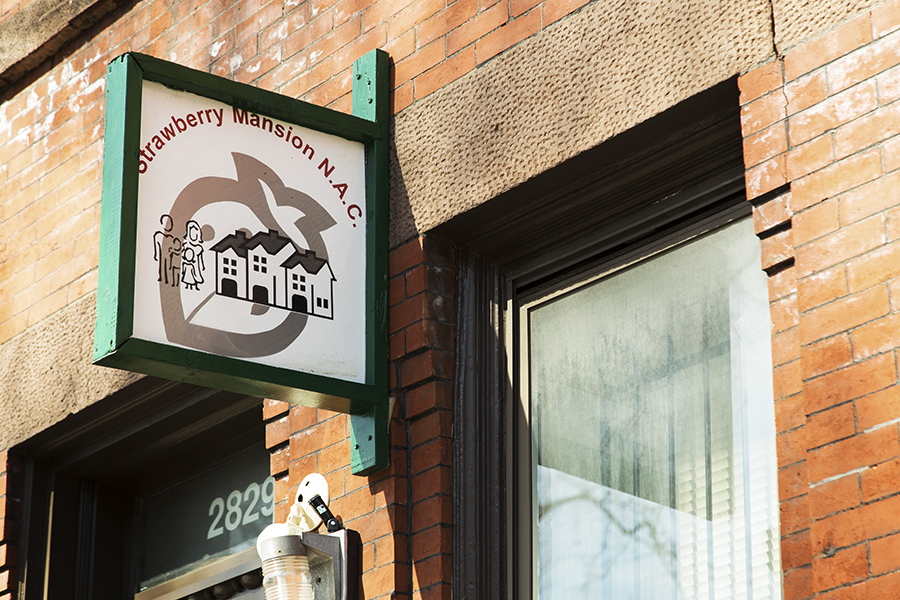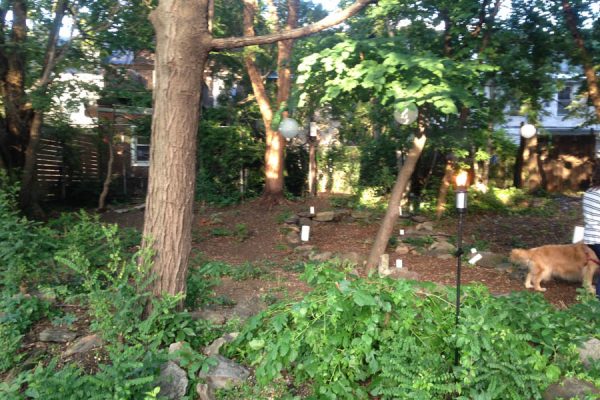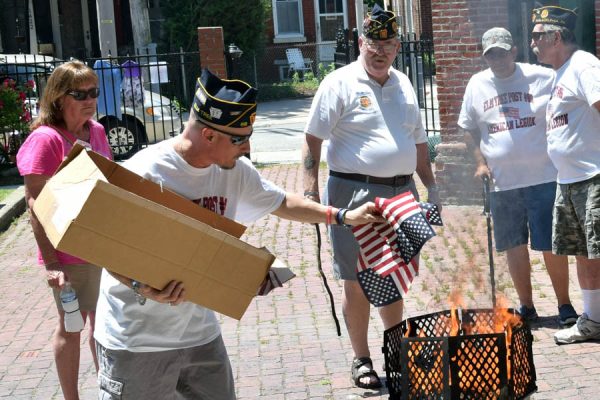Strawberry Mansion NAC/CDC: Preserving a Neighborhood’s Past While Investing In Its Future
For nearly ten years, two community organizations have worked together in Strawberry Mansion to make lives easier for residents and guide development so those lifestyles do not wither.
The Neighborhood Action Center (NAC) arose in November 2004, two years prior to the Strawberry Mansion Community Development Corporation (CDC). The NAC focuses on community planning and quality of life issues, according to its community liaison, Tyrone Williams. It is funded by the city’s Office of Housing and Community Development. The CDC, founded in 2006, is concerned with pressing the community’s interests on steering physical development plans for Strawberry Mansion.

Marcella Bevans, Tonnetta C. Graham and Lenora Jackson-Evans of the Strawberry Mansion NAC & CDC/Thomas Weir
According to the CDC’s website, the neighborhood of Strawberry Mansion stretches north from Cecil B. Moore Avenue to Lehigh Avenue, with the Schuylkill River on the west and Amtrak’s Northeast Corridor rail tracks, roughly Sedgley Avenue, on the east.
One of the NAC’s most popular and impactful initiatives is the Neighborhood Energy Center (NEC), according to Williams. The NEC helps residents afford winter heat and keep utility services from being shut off all together. Marcella Bevans, the NAC’s energy monitor, said she helps residents apply to various energy assistance programs. These programs include the state of Pennsylvania’s Low Income Home Energy Assistance Program (LIHEAP) and Crisis programs, the city’s crisis assistance plan for rent and utility bills, and Utility Services Emergency Funding (USEF) for utility shutoffs.
Williams explained that without such help, many residents would needlessly suffer. He said millions of dollars made available by the state through LIHEAP and Crisis for Philadelphia assistance are returned each year because people do not feel they are qualified to apply for it.
But the NAC cares for more than people’s pocket books: Williams said it also keeps residents apprised of current issues and listens to their concerns at regular community meetings. Agenda items — ranging from actions by or requirements of the Department of Licenses and Inspections to sightings of raccoons in the neighborhood — are decided on by listening to concerns of residents.
In addition to those meetings, the NAC composes a quarterly newsletter to keep residents apprised of its actions and the state of the neighborhood. “We’re an information hub for the neighborhood,” Williams said.
Williams says that one of the NAC’s notable successes was stopping SEPTA’s plan to reconfigure its bus shelter at 33rd and Dauphin Streets. SEPTA’s plans for renovations of the routing spot for three bus lines did not sit well with the community and because of the controversy, SEPTA delayed action. With the help of the Neighborhood Preservation Alliance, Williams said the facility was deemed a national historic site, preventing SEPTA’s contentious alterations.
Outwardly, to the community, the NAC’s most obvious presence may be its Keyspot computer lab for community members who do not have access to the Internet, which draws 200 users each month, according to NAC executive director Lenora Jackson-Evans. She said the lab is an example of the NAC’s tagline: “Rebuilding the community through empowerment.”
Lawrence Battle is a volunteer assistant at the lab two days a week. He said the lab is open weekdays from 9AM to 5PM and that in a typical day an average of forty people use the lab. The computers were provided by Keyspot (a program of the Obama Administration to bridge the digital divide), Broadband USA and the federal Empowerment Zone initiative.
Battle is himself, along with the lab’s other assistants, provided by Keyspot, for which they directly volunteer. He said he performs the same functions at two other computer labs.
“Strawberry Mansion needs us here,” Battle said. ”It’s one of the few places where you can use computers for free.”
Aside from helping people with technology at the site, Battle said he helps users learn how to operate any electronic devices.” I’m here to show what they can do, to help to make their lives easier and to show them that their technology is nothing to be afraid of.”
The lab is mostly visited by seniors or other adults “brushing up on their skills,” he said, but added that it is also heavily used by kids who are homeschooled and need a place to complete assignments. “Nine times out of ten I’m here to help out as well… Keyspot is here to help the community and I’m here to help the community with Keyspot.”
Young people are given specific attention and aid in finding employment and applying to school, said lab volunteer Lindsey Edwards. That service is sometimes pushed to the limit when any of the other 79 Keyspots in the city are overwhelmed with users and send kids to the Strawberry Mansion site, putting extra pressure on its resources.
Edwards also said Keyspot would like to expand its two summer computer camps in the city, combined with a summer lunch program offered by the Archdiocese of Philadelphia, and pay its volunteers, or at least offer them a stipend for transportation costs to keep them from leaving for paid work elsewhere. But additional funding is needed for all that.
For all that the lab is able to do, Edwards says much more could be done with additional funding. “The challenge is to find funds for every [Keyspot] lab,” Edwards said.
But being able to keep up with the latest technology is only part of what Strawberry Mansion has to offer its residents. According to Tonnetta Graham, president of the Strawberry Mansion CDC, two community gardens give people a chance to work and grow their own food in the form of plot boxes directly on the ground. She said they are located at 32rd Street and Ridge Avenue and 31st Street between Berks and Norris Streets. A greenhouse at Strawberry Mansion High School, across Ridge Avenue from the garden, will allow farming in the winter, she added.
Graham explained that although the CDC and the NAC share a business office, the two neighborhood organizations are two separate entities with different approaches to the neighborhood’s concerns. But they use each other’s strengths to meet their own obligations. “It’s great that we’re two. We’re able to cover so much,” she said.
For the CDC’s part in that struggle, she tries to keep development in the neighborhood in line with what works best for its residents. She said Strawberry Mansion has always had a high rate of homeownership and there are also many low-income developments of the Philadelphia Housing Authority (PHA) in the neighborhood. Now, she added, many market-rate residential developments and mixed-use projects are going up.
Graham said PHA will begin constructing 52 units of affordable housing at the intersection of 33rd Street and Arlington (ground has already been cleared for the project) and Eastern Apartments, a renovation project underway at 30th Street and Cecil B. Moore Avenue that will open its 32 1-, 2- and 3-bedroom apartments in the spring of this year.
But that new construction is being built to draw new residents. Graham says the two neighborhood support groups want to make sure that a path to sustainability is also made clear for existing residents. “We have an aging housing stock in Strawberry Mansion,” she said. ”We would like to see renovation programs.”
Whatever the nature of a development, Graham said the CDC likes to keep the neighborhood involved with all levels of the project. She said the CDC has a contractor pool including both union and non-union work forces that they choose to use for jobs. She added that any contractor who is awarded a job must, by contract, hire from the community — a requirement guided by the CDC’s tagline: “Preserving our past, investing in our future.”
And it is the NAC’s tagline: ”Financial Empowerment…to improve credit” that is behind the NAC’s Financial Empowerment Center, which helps people prevent foreclosure on their home loans by connecting them to a city program that guides residents through that process. Assistance is also given to residents applying for the city’s Homestead Exemption Plan to reduce the real estate tax.
The NAC also counsels people to keep an eye on their budgets and the number of household residents when applying because the income of an entire home and the number of people relying on it can affect an applicant’s eligibility, said Williams.
“We have many… failsafes in place,” said Williams. ”Without [them] many of these residents would fall. We’re a one-stop shop for community services.”








